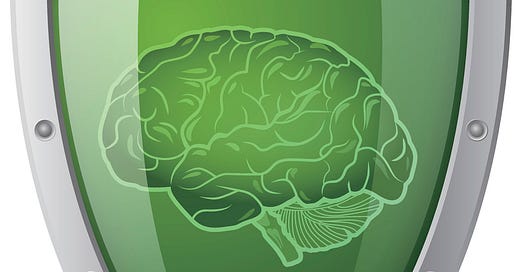Behavioral Defense Strategies: How to Make Smart Investment Decisions
Surprisingly under-used techniques that are important for the health of your portfolio
As an investor, you may try to capitalize on the mistakes of others in the market by practicing behavioral offense. However, it is just as important to protect yourself against your own biases through behavioral defense. Unfortunately, many investors do not prioritize this aspect of their strategy, to the detriment of their portfolios. This article will provide guidance on how you can begin implementing behavioral defense in your investment approach.
Who should you be defending against?
As an investor, it's crucial to be aware of the various biases and techniques that can impact the quality of your decisions. While it's important to safeguard against others who may try to use behavioral tricks on you to their advantage, the most important source to defend against is yourself. Without proper awareness and correction, your own biases can lead to flawed judgment and poor investment decisions.
In this article, we'll examine common biases and techniques that you should be on the lookout for, as well as strategies for how to defend against them. By implementing behavioral defense, you can make more informed investment choices and safeguard your portfolio against losses.
Your behavioral biases
There are too many biases to discuss in this article, so I chose to focus on a handful of common ones that have the potential to have the biggest impact on the quality of your decisions.[i]
Overconfidence – This one doesn’t need much of an explanation – most of you have probably heard of numerous studies in which the majority of members in a group think they are better at something than the average member of that group (e.g. more than half of drivers believe they are above-average drivers). While this affects most people, surely you have above-average humility, right?
Base-rate Neglect – The base rate probability of an event is the frequency with which the event has occurred historically. If you hear hoof beats and the only animals with hoofs in your area are horses and zebras, the likelihood is that you are hearing a horse because there are a lot more horses than zebras. With no additional information the base-rate probability that the sound is coming from a horse is much higher.
What if you think you briefly glimpsed a dark stripe in the distance but can’t be sure? It’s still far more likely that it’s a horse than a zebra, and those who forget about the base-rate probability and over-weigh the small incremental evidence to conclude that they are hearing a zebra are succumbing to the base-rate neglect bias.
Anchoring – We are frequently loathe to change our opinion from our initial conclusion, even when the evidence merits doing so. Furthermore, the presence of sometimes irrelevant initial information can influence our analysis.
As an example, a study separated people into two groups at random. The first was asked if a certain well-known river was longer or shorter than 10 miles, and afterwards was asked for an estimate of the length of the river. The second group was asked the same questions, except that 1,000 miles instead of 10 was substituted in the first question. The result was that the average estimate of the length of the river of the second group was much larger than that of the first group simply based on the different “anchor” in the first question.
Recency Bias – This bias can lead you to believe that the recent past trends are more predictive of the future than they are likely to be. A company that has had poor recent financial results can be perceived by investors to have a higher likelihood of similar future results than an examination of that company’s complete track record might suggest.
Behavioral defense against others’ influence
Again, there are too many biases to discuss in this article, so I focus on a handful of common techniques to guard against. For a more exhaustive treatment of the topic I recommend reading Cialdini’s classic Psychology of Influence and his more recent follow-up work, Pre-Suasion[ii].
Social Proof – The persuader uses the claim that others have done X to get you to also do X. This can take the form of them claiming a large number of people similar to you have already done X, or one particularly influential individual or organization having done it. The goal is to short-circuit the part of your brain that will cause you to think for yourself and instead activate the evolutionary herding instinct to get you to blindly comply.
Scarcity – People have evolved in a way that makes them desire an object that is scarce more so than the same object that is plentiful. Be on alert for persuaders invoking this effect by making you believe (whether truthfully or not) that the object of your deliberations is about to run out.
Commitment and Reciprocity – Commitment techniques use people’s tendency to be consistent with their prior actions. These usually take the form of asking for a small favor, and after receiving it using the more biased state of mind to get you to agree to give or do something that you wouldn’t have otherwise. Reciprocity uses a similar idea, except the persuader does you a small favor, putting you in a state of mind that is pre-biased towards favoring them.
Defending against behavioral biases
The reason behavioral biases are so dangerous to your decision making process is that frequently they can affect you without you realizing that you are under their influence. After reading some of the above, you might think to yourself, “Gee, these seem pretty obvious, I am not likely to fall for them given my level of sophistication.” If that thought went through your head, rest assured that you are not alone (see the overconfidence bias above). The only way that I know of that can help guard against these biases is a combination of the following:
Use checklists. Atul Gawande showed that even highly experienced professionals performing routine tasks will make fewer errors if they force themselves to use a checklist as part of their process.[iii] I also believe that having a behavioral bias checklist – asking yourself explicitly whether any of a list of typical biases are potentially affecting your state of mind – can weaken their influence.
Use a thorough and consistent decision-making process. Spend some time establishing an appropriate process for common decision types when you are at your most rational and are not in the midst of making any decisions. Then fully stick to it for each decision in that category, no matter how tempting it might be to take shortcuts.
Allow sufficient time to pass between the initial idea and making an important decision. While time alone won’t counteract all behavioral biases, it can weaken their impact and allow you to be more objective.
Preempt influence attempts. Sometimes it is easier to avoid being influenced than defend against an influence attempt.
When you detect behavioral influence attempts, consider stopping the evaluation process. If you detect that someone is using behavioral techniques to influence you, consider not proceeding further with the evaluation, as it might not be possible to be fully objective about how much you have already been influenced. In other words, the next time you hear from a seller that many people like you have already bought an item and it is about to run out (although the seller has reserved just enough for you), consider politely declining doing business with the person who feels the need to use these techniques to get you to see their value proposition.
About the author
Gary Mishuris, CFA is the Managing Partner and Chief Investment Officer of Silver Ring Value Partners, an investment firm that seeks to apply its intrinsic value approach to safely compound capital over the long-term. He also teaches the Value Investing Seminar at the F.W. Olin Graduate School of Business.
Note: An earlier version of this article was published on the Behavioral Value Investor site.
[i] You can find a more comprehensive overview at https://betterhumans.coach.me/cognitive-bias-cheat-sheet-55a472476b18#.wizkvkdj9
[ii] Psychology of Influence and Pre-Suasion by Robert B. Cialdini
[iii] The Checklist Manifesto by Atul Gawande





